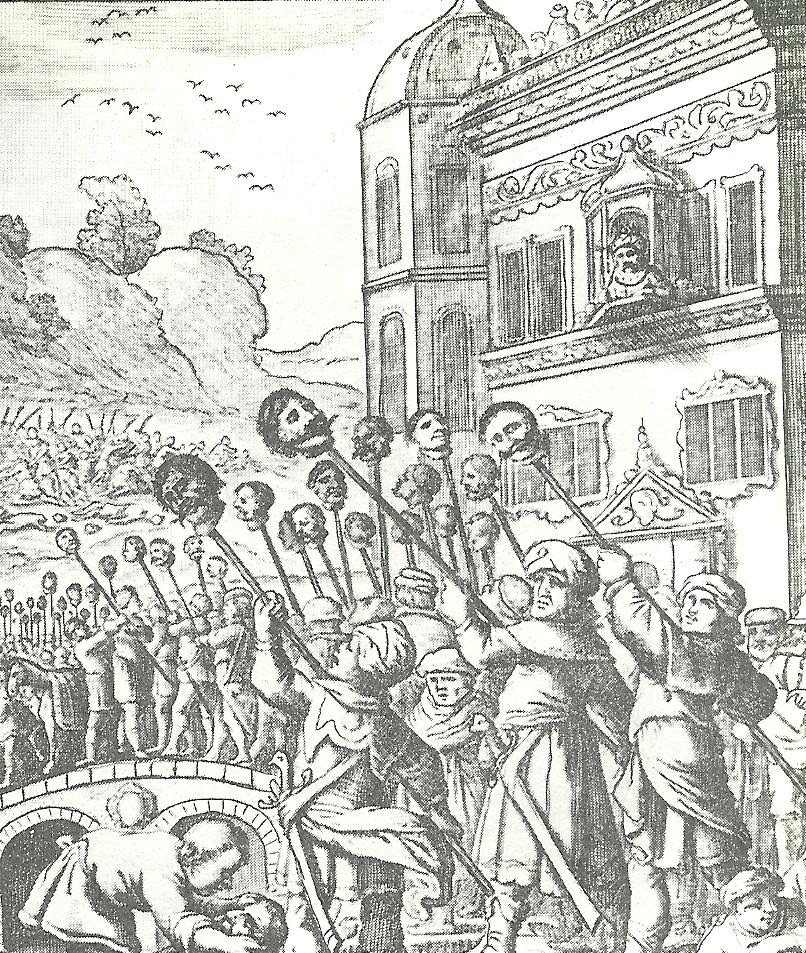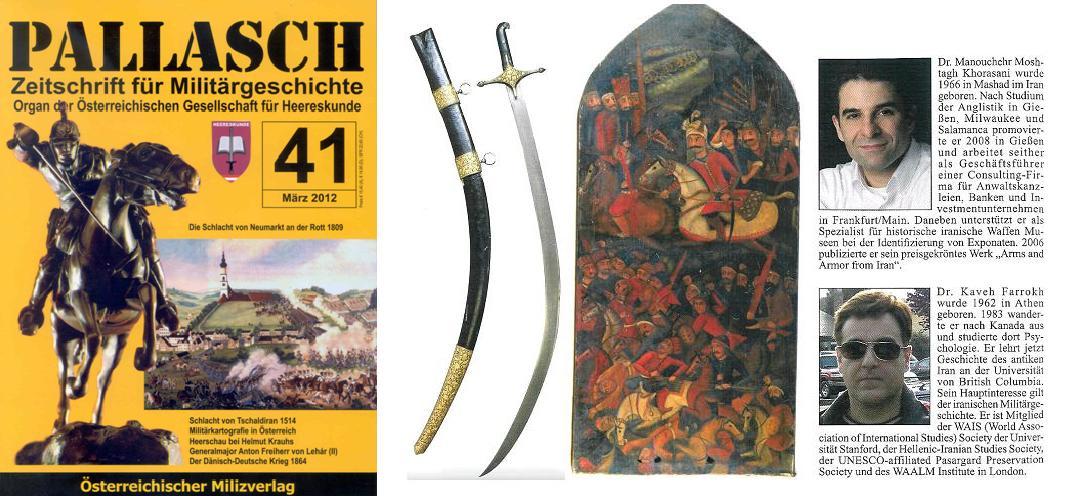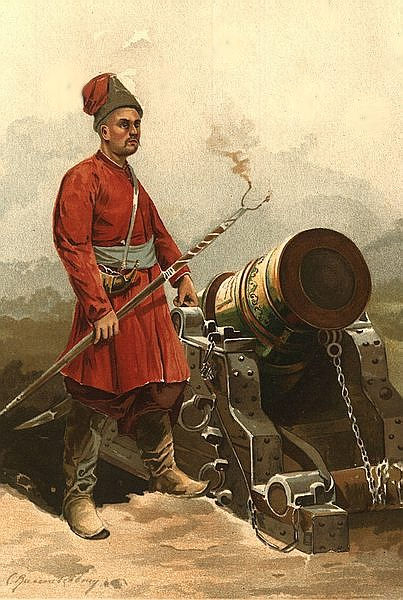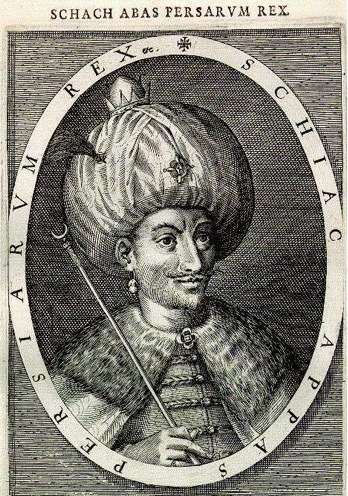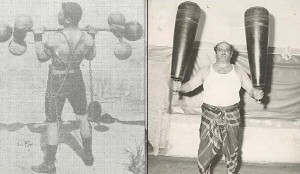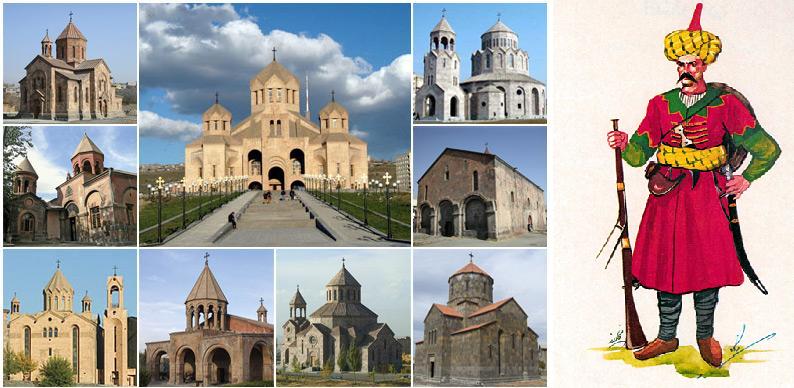The Ottoman Turks had defeated the Iranian army of Shah Ismail I (r. 1501-1524) at the Battle of Chaldiran on August 23, 1514. In the disastrous aftermath of the ensuing Ottoman-Safavid wars, much of Iran’s Azarbaijan province (including its provincial capital Tabriz), Armenia (known as the Irvan Khanate in Medieval Iranian sources) and the Caucasus fell under the occupation of the Ottoman Turks.
The Ottoman Turks also occupied many of the Caucasian Khanates such as Irvan Khanate (modern Republic of Armenia) as well as much of those Caucasian territories (i.e. Shamakhi, Nakhchevan, etc.) known as the Republic of Azarbaijan since May 1918 (i.e. Shamakhi, Nakhchevan, etc.). [Click to Enlarge]Recently published article by Kaveh Farrokh and Manouchehr Moshtagh Khorasani on the Battle of Chaldiran by major peer-reviewed military history journal based in Austria: Pallasch: Zeitschrift für Militärgeschichte, Organ der Österreichischen Gesellschaft für Heereskunde. At left is the cover page of the journal; at center is a Safavid sword and a Qajar era painting of the battle of Chaldiran and at right are the profiles of the authors (in German). The peer board of Pallasch consists of high-ranking European military officers. The citation of the journal article for reference is: Farrokh, K., & Khorasani, M.M. (2012). Die Schlacht von Tschaldiran am 23. August 1514, Pallasch: Zeitschrift für Militärgeschichte, Organ der Österreichischen Gesellschaft für Heereskunde. Heft 41, März 2012, pp. 47-71. Despite their status as the world military superpower of the day, their deployment of heavy firepower (muskets and cannon) as well as larger numbers of troops, the Ottoman Turks failed to destroy the Iranian army. This was due to important military reforms (especially in the creation and integration of firearms units within the Iranian army) as well as a revived Iranian martial arts tradition (discussed further below). [Click to enlarge]Iranian artilleryman of the type serving in the Iranian armies of Shah Abbas I during his campaigns which cleared the Ottoman Turks out of Western Iran (notably Luristan and Kurdistan), northwest Iran (especially Azarbaijan province) and the Caucasus in the early 1600s (Picture source: Historum.com). The Iranians facing the Ottoman armies in 1514 at the Battle of Chaldiran had no cannon or muskets; Shah Ismail and his cavalry suffered very heavy losses by repeatedly charging into the Ottoman lines in their endeavor to silence the Ottoman Sultan’s 500 cannon! Important military reforms which had begun at the time of Shah Tahmasp I (r. 1524-1576) reached their apogee at the time of Shah Abbas I (r. 1587-1629), especially in the latter’s success in fully integrating firearms into the Safavid battle order. The latter task was assisted by the English brothers, Anthony and Robert Shereley. Vincenzo D’Alessandri a European visitor to Iran arriving in 1571, reported that: “Persians are tall and strong… commonly use swords, lances and guns on the battlefield…Persian Musketeers use their muskets so adeptly…they will draw the sword at times of necessity…muskets are slung to the back as to not interfere with the usage of bows and swords…their horses are very well trained and they [the Iranians] have no need to import horses…” [As cited in Amiri, M. (1970). Safarnameye Venezian dar Iran [The Travelogues of the Venetians in Persia]. Tehran: Entesharat-e Kharazmi, pp.448-449]. Despite fielding smaller numbers of troops, the reformed Safavid armies of Shah Abbas I defeated the Ottoman Turks and liberated Tabriz from Turkish occupation on October 21, 1603 (after 20 days of fighting). Note that the sources cited in this article thus far are clear that the Safavids are Iranians; they are consistently refered to as “Persians” in reference to their historical and cultural links to the wider Iranian mileau. Therefore, the fact that many of the Iranian Azarbaijanis had become Turcophone was simply another facet of their Iranian identity – Iranians are not limited to Persian-speakers only, as Iranian culture is multi-faceted and characterized by diversity and synthesis within an Iranian cultural framework. Note the observations of a European traveller to Iran named Antonio Tenreiro in 1525 and his descriptions of the inhabitants of the city of Tabriz: “This city [Tabriz] is inhabited by Persians and some Turkomans, white people, and beautiful of face and person” [Ronald Bishop Smith (1970), The first age of the Portuguese embassies, navigations and peregrinations in Persia (1507-1524), Decatur Press, pp. 85-86.]. It should be noted that the Turkoman tribes cited above were religious followers of the Safavid dynasty (themselves originally of the Iranian pedigree but progressively Turkicized linguistically, hence of the Persianate civilizational realm). These had migrated from the Anatolian regions and became the military backbone of the early Safavid dynasty. It was these same Turcomens who had stood up with Shah Ismail against the Ottoman Turks in the Battle of Chaldiran in 1514. It is clear that the Ottoman Turks had intended to hold Tabriz and all of Azarbaijan under permanent occupation. In a letter written by Shah Abbas to Jalal e Din Mohammad Akbar (the powerful emperor of India and contemporary of Shah Abbas, whom the Iranian king always addressed as father) after the liberation of Tabriz, he had noted that the Ottomans in Tabriz had: “…200 cannon, 5000 musketeers…supplies lasting for ten years and much equipment for the holding of fortresses…” [Falsafi, N. (1965). Zendeganiye Shah Abbas Avval [The Life and Times of Shah Abbas the First] (6 Volumes). Tehran University, Volume IV, pp.22-23.]. [Click to enlarge] Shah Abbas I (r. 1587-1629) as depicted in a European copper engraving made by Dominicus Custos citing him as“Schach Abas Persarum Rex” or “Shah Abbas the Great monarch of Persia”. Note how Custos makes a particular emphasis on linking Shah Abbas to the “Mnemona Cyrus” (the Memory of Cyrus the Great of Persia). Shah Abbas’ victories over the Ottomans weakened them against the Europeans to the West, and especially in the Balkans and Eastern Europe. Shah Abbas I then thrust into the Caucasus to expel the Ottoman Turks from the Irvan Khanate and the rest of the Caucasus. The occupying Ottoman garrison of Irvan (Yerevan) city lost 2000 troops in just a few hours after it was forced by the Iranians into close-quarter combat; the Ottoman were then forced to surrender in June 1604. [Click to enlarge] The Zoorkhaneh or “House of Power”. The Zoorkhaneh is the traditional Iranian martial arts school which has for centuries been an important medium for the training of Iranian warriors. The roots of this can be traced to the pre-Islamic Zoroastrian tradition. At right is Pahlavan (lit. brave intrepid champion) Mustafa Toosi wielding Zoorkhaneh meels at 60 pounds each (Picture source: Pahlavani.com). Meel training is one of the Zoorkhaneh regiments used for building strength, stamina, and overall physical strength. Each Meel can range from 25-60 pounds and can be as tall as 4 ½ feet. At left is Pahlavan Reza Zanjani with traditional Iranian weights (Picture source: Abbasi, M. (1995), Tarikh e Koshti Iran [History of Wrestling in Iran], Tehran: Entesharate Firdows, page 133.). The Iranian ascendancy over the Ottomans had much to do with the revival and promotion of Iran’s ancient martial arts tradition by the Safavids. As noted by Jean Chardin, a French Huguenot jeweller who had arrived in Iran in 1665: “…the youth, much like the times of ancient Persia, are introduced to martial exercises…” [Abbasi, M. (1956). Siyahatnameye Chardin [The Travelogues of Chardin] (10 volumes). Tehran: Amir Kabir, Volume III, p.179.] Yet another European travellor to Iran, Giovanni Battista Vecchietti reported the Iranians in the late 16th century as being: “…expert in fighting with sword, lance and bow, and… greatly superior to the Turks in this” [As cited by Matthee, R.P., 1991, The Politics of Trade in Safavid Iran. Cambridge: Cambridge University Press, p.394]. Regarding this topic consult Professor M. Haneda: Iranian Safavid Armies, Iran at War:1500-1988, 2011, pp. 28-41, 56-61 and Dr. Manouchehr M. Khorasani’s upcoming text “Persian Archery and Swordsmanship: Traditional Martial Arts of Iran”. Shah Abbas I completed his defeat of the Ottomans by crushing their counteroffensive in Iran’s Azarbaijan province (November 6, 1605). He then cleared the Ottoman Turks out of Ganja and Shamakhi in the Caucasus by late June 1606 . The Ottomans once again attempted to occupy Tabriz and Yerevan in 1616-1618, by deploying 200-300,000 troops and heavy firepower. Once again, they were defeated and expelled back into Ottoman territory by Shah Abbas I (see Iran at War:1500-1988, 2011, pp. 56-61). [Click to Enlarge] (LEFT-Picture source: Yerevan.Am) Modern-day Yerevan and traditional Armenian churches; (RIGHT-Picture source: Historum.com) Safavid musketeer of the type contemporary to Iranian forces liberating Yerevan from the Ottoman Turks in 1604; it is notable that among the troops liberating Yerevan were musketeers from Iran’s Azarbaijan province.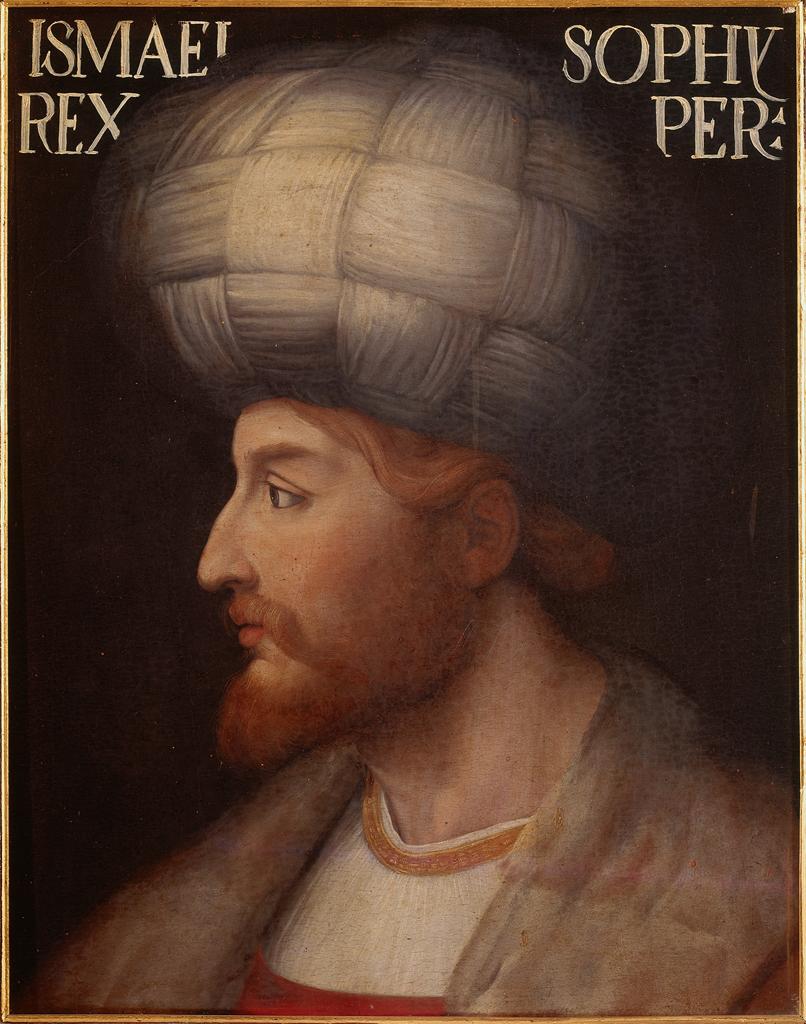
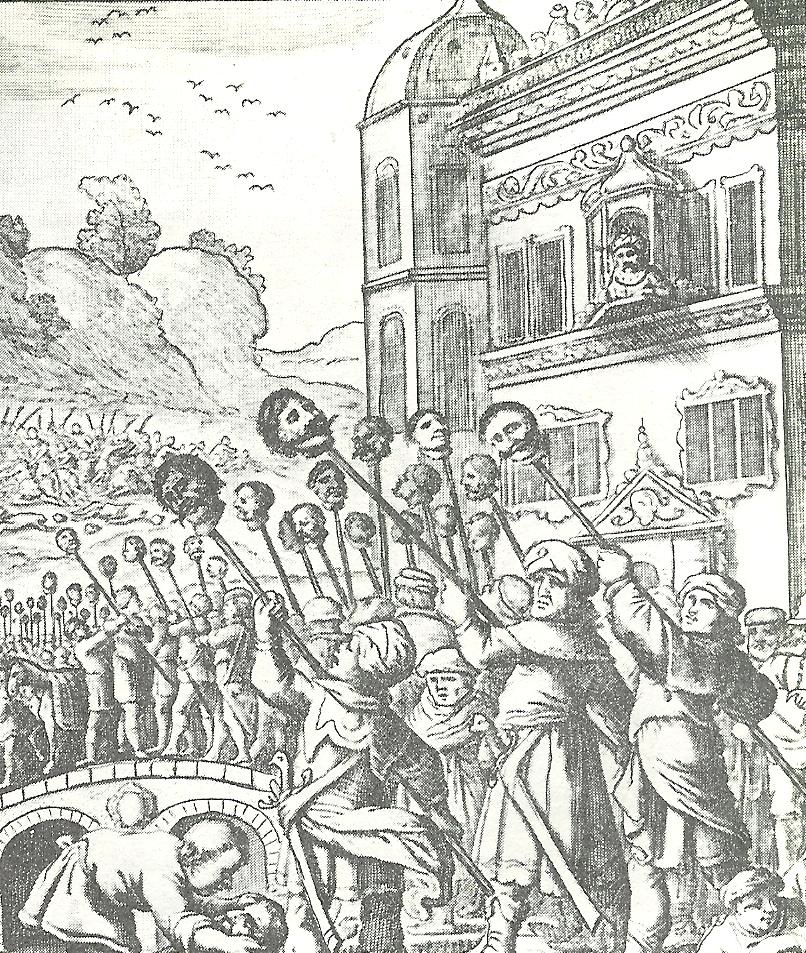 Rare drawing by a European traveller who witnessed the aftermath of the liberation of Tabriz by Shah Abbas I on October 21, 1603. Local Azari citizens welcomed the Iranian Safavid army as liberators and took harsh reprisals against the defeated Ottoman Turks who had been occupying their city. Many unfortunate Turks fell into the hands of Tabriz’s citizens and were decapitated (Picture Source: Matofi, A., 1999, Tarikh-e-Chahar Hezar Sal-e Artesh-e Iran: Az Tamadon-e Elam ta 1320 Khorsheedi, Jang-e- Iran va Araqh [The 4000 Year History of the Army of Iran: From the Elamite Civilization to 1941, the Iran-Iraq War]. Tehran:Entesharat-e Iman, p.63).
Rare drawing by a European traveller who witnessed the aftermath of the liberation of Tabriz by Shah Abbas I on October 21, 1603. Local Azari citizens welcomed the Iranian Safavid army as liberators and took harsh reprisals against the defeated Ottoman Turks who had been occupying their city. Many unfortunate Turks fell into the hands of Tabriz’s citizens and were decapitated (Picture Source: Matofi, A., 1999, Tarikh-e-Chahar Hezar Sal-e Artesh-e Iran: Az Tamadon-e Elam ta 1320 Khorsheedi, Jang-e- Iran va Araqh [The 4000 Year History of the Army of Iran: From the Elamite Civilization to 1941, the Iran-Iraq War]. Tehran:Entesharat-e Iman, p.63).
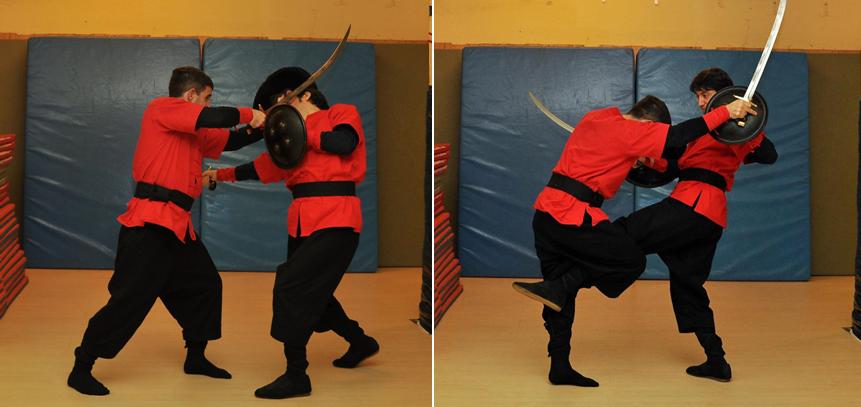 [Click to Enlarge]Dr. Manouchehr Moshtagh Khorasani (at left in each photo) demonstrating hand to hand combat techniques in accordance with tradtional Iranian martial arts techniques. As the Ottoman Empire had vastly larger numbers of troops than Iran, the Safavids developed an excellent core of professional fighters who were often capable of standing up to larger numbers of Ottoman troops (Photos to appear in Dr. Manouchehr Moshtagh Khorasani’s upcoming text “Persian Archery and Swordsmanship: Traditional Martial Arts of Iran”).
[Click to Enlarge]Dr. Manouchehr Moshtagh Khorasani (at left in each photo) demonstrating hand to hand combat techniques in accordance with tradtional Iranian martial arts techniques. As the Ottoman Empire had vastly larger numbers of troops than Iran, the Safavids developed an excellent core of professional fighters who were often capable of standing up to larger numbers of Ottoman troops (Photos to appear in Dr. Manouchehr Moshtagh Khorasani’s upcoming text “Persian Archery and Swordsmanship: Traditional Martial Arts of Iran”).

